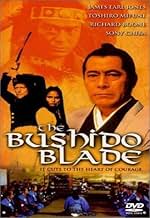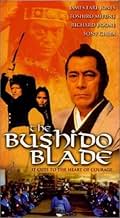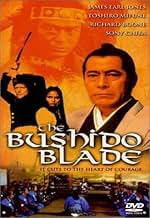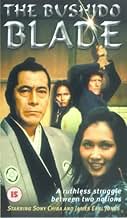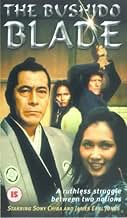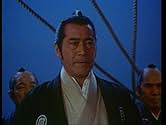IMDb-BEWERTUNG
5,3/10
468
IHRE BEWERTUNG
Füge eine Handlung in deiner Sprache hinzuA steel samurai blade that was to be given to the American ambassador by the Emperor of Japan is stolen. American sailors and Japanese samurai are sent to find it.A steel samurai blade that was to be given to the American ambassador by the Emperor of Japan is stolen. American sailors and Japanese samurai are sent to find it.A steel samurai blade that was to be given to the American ambassador by the Emperor of Japan is stolen. American sailors and Japanese samurai are sent to find it.
Mike Starr
- Bos'n Cave Johnson
- (as Michael Starr)
Timothy Patrick Murphy
- Midshipman Robin Burr
- (as Timothy Murphy)
Shin'ichi Chiba
- Prince Ido
- (as Sony Chiba)
Hitoshi Ômae
- Sumo
- (as Kin Omai)
Empfohlene Bewertungen
The picture develops the true tale of commandant Perry (Richard Boone's final show) -along with his underlings- who during the nineteenth century is sent by the US President to Japan to serve as the first U.S. As in 1852 , Perry was assigned a mission by American President Millard Fillmore to force the opening of Japanese ports to American trade , through the use of gunboat diplomacy if necessary Consul-General to that country . Perry (considered father of the Steam Navy) finally reached Uraga at the entrance to Edo Bay in Japan on July 8 , 1853 . In the meantime , the Japanese government was paralyzed due to the incapacitation by illness of Shogun Tokugawa Ieyoshi and by political indecision on how to handle the unprecedented threat to the nation's capital . Later on , a steel samurai blade that was to be given by the Japanese high authority (Toshiro Mifune) to the American ambassador from the Emperor of Japan is stolen . After that , American sailors : Bos'n Cave Johnson (Mike Starr), Midshipman Robin Burr (Timothy Patrick Murphy) , Captain Lawrence (Frank Converse) and Japanese samurai (Sonny Chiba) are sent to find it . They discover enormous hostility to foreigners, as well as dangers and risks . There Robin finds romance with a gorgeous girl and Captain Lawrence meets a samurai woman (Laura Gemser) . Meanwhile , they confront the Shogun army , and Lord Yamato (Tetsurô Tanba) . The Japanese attackers follow the Bushido code , it means honor but also revenge , bloodshed and violent death! . The Bushido blade cuts to the heart of courage .
Richard Boone becomes the first Ambassador from the Western world is this oriental adventure . The film deals with conflicts between the radical conservatism and modernism ; upon relation of the West and East World . In addition , a sweeping , human drama with all the ingredients : adventures , betrayal , romance , inter-racial love story , emotions , breathtaking battles , spellbound scenarios and results to be pretty interesting . Stunning images illuminate the full-blown feats of a bunch of sailors under impressive Japanese sets . It's an acceptable epic in medium budget , including an agreeable statement about honor , tradition and futility of war . Glimmer and colorfully cinematography shot on location in London , England, UK and Tokyo , Japan ; though a perfect remastering is necessary . Evocative and appropriate score , including a catching leitmotif , by Maury Laws . Panned by the critics , the movie was a flop at box office in USA , receiving awful reviews . However , nowadays is best deemed . The motion picture was professionally directed by Tom Kotani , though it has some gaps as well as flaws and uneven pacing .
This costumer picture is based on historic events . As Perry returned in 1854 with ten ships and 1600 men and he carried out the Opening of Japan , as called The Perry Expedition: 1852–1854 . After initial resistance by the Japanese , Perry was permitted to land at Kanagawa, near the site of present-day Yokohama where after negotiations lasting for around a month , the Convention of Kanagawa . Perry signed as American plenipotentiary, and Akira signed for the Japanese side. Perry departed , mistakenly believing the agreement had been made with imperial representatives , not understanding the true position of the Shogun, the de facto ruler of Japan . As Japan was dominated for a dynasty occupied by the Togugawa family from century XVI until 1868 and characterized by ruling ¨Daimios ¨ , confronting occidental people and shunning the opening imposed by Admiral Perry in 1863 ; he was the first foreigner in Japan who undergoes a culture shock . Being dead emperor Komei , succeeded in 1867 , Mutsu Hito , one time crowned as emperor Meiji , he abolished the Shogun . Matsu Hito carried out various changes, as a liberal cabinet , creating a Duma or Parliament and following actual models and modern spirit . Anti-reforms riots to return old values , traditional way of life and code Bushido were realized by the Samurais a type of medieval knight for preventing of occidental life style . These events have been developed in various films as ¨Barbarian and Geisha¨ by John Huston , considering John Wayne is horribly miscast that resulted to be one of the worst of his bad films , ¨The last Samurai¨ by Edward Zwick with Tom Cruise , Ken Watanabe , Billy Connolly , Tony Goldwyn and the magnificent TV series ¨Shogun¨ (1980) with Richard Chamberlain . Although ¨The Bushido blade¨ was derided as an attempt to copy the hit TV mini-series "Shogun", it was actually made in 1980, before "Shogun", though it wasn't released until after that series had aired .
Richard Boone becomes the first Ambassador from the Western world is this oriental adventure . The film deals with conflicts between the radical conservatism and modernism ; upon relation of the West and East World . In addition , a sweeping , human drama with all the ingredients : adventures , betrayal , romance , inter-racial love story , emotions , breathtaking battles , spellbound scenarios and results to be pretty interesting . Stunning images illuminate the full-blown feats of a bunch of sailors under impressive Japanese sets . It's an acceptable epic in medium budget , including an agreeable statement about honor , tradition and futility of war . Glimmer and colorfully cinematography shot on location in London , England, UK and Tokyo , Japan ; though a perfect remastering is necessary . Evocative and appropriate score , including a catching leitmotif , by Maury Laws . Panned by the critics , the movie was a flop at box office in USA , receiving awful reviews . However , nowadays is best deemed . The motion picture was professionally directed by Tom Kotani , though it has some gaps as well as flaws and uneven pacing .
This costumer picture is based on historic events . As Perry returned in 1854 with ten ships and 1600 men and he carried out the Opening of Japan , as called The Perry Expedition: 1852–1854 . After initial resistance by the Japanese , Perry was permitted to land at Kanagawa, near the site of present-day Yokohama where after negotiations lasting for around a month , the Convention of Kanagawa . Perry signed as American plenipotentiary, and Akira signed for the Japanese side. Perry departed , mistakenly believing the agreement had been made with imperial representatives , not understanding the true position of the Shogun, the de facto ruler of Japan . As Japan was dominated for a dynasty occupied by the Togugawa family from century XVI until 1868 and characterized by ruling ¨Daimios ¨ , confronting occidental people and shunning the opening imposed by Admiral Perry in 1863 ; he was the first foreigner in Japan who undergoes a culture shock . Being dead emperor Komei , succeeded in 1867 , Mutsu Hito , one time crowned as emperor Meiji , he abolished the Shogun . Matsu Hito carried out various changes, as a liberal cabinet , creating a Duma or Parliament and following actual models and modern spirit . Anti-reforms riots to return old values , traditional way of life and code Bushido were realized by the Samurais a type of medieval knight for preventing of occidental life style . These events have been developed in various films as ¨Barbarian and Geisha¨ by John Huston , considering John Wayne is horribly miscast that resulted to be one of the worst of his bad films , ¨The last Samurai¨ by Edward Zwick with Tom Cruise , Ken Watanabe , Billy Connolly , Tony Goldwyn and the magnificent TV series ¨Shogun¨ (1980) with Richard Chamberlain . Although ¨The Bushido blade¨ was derided as an attempt to copy the hit TV mini-series "Shogun", it was actually made in 1980, before "Shogun", though it wasn't released until after that series had aired .
Bushido Blade is a film that kind of got lost with all the hoopla surrounding the Shogun TV mini-series. Commodore Perry's opening of Japan deserved a better treatment than what it got here.
No reflection on the cast, they certainly try hard enough. And the making of the film is a service of sorts because America is woefully ignorant about Japan other than knowing that they were our opponents in World War II.
Making his farewell appearance on the screen is Richard Boone as the crusty Commodore Matthew Calbraith Perry. From what little I know of Perry, Boone seems to have captured him very well. Perry was the younger brother of Oliver Hazard Perry who was the commander of the Great Lakes Navy that beat the British and kept them from invading us through Canada. Younger brother Cal (family and friends used Perry's middle name when addressing him)served in the United States Navy for over 30 years and the opening of Japan was the capstone of a great career.
Bushido Blade is a fictional sideline to the true events surrounding the treaty Perry signed with the Shogun. There was a faction in Japan who wanted to keep the country's isolationist policy going and were quite willing to do anything in that endeavor. They steal a ceremonial samurai sword that is to be presented to President Franklin Pierce by Perry. As this is a question of honor, the Japanese balk at signing the treaty at the last minute.
The Japanese insist on themselves recovering the sword, but Perry unofficially sends Marine Captain Frank Converse, Boatswain Mike Starr, and young Naval Midshipman Timothy Patrick Murphy on his own mission. The three get split up during an attack. The bulk of the film is the separate experiences of all three.
Frank Converse is a fine actor, but I couldn't quite believe him as an instant Samurai. When he has to battle the champion Samurai he gets a bit of help to say the least. Skill with a Samurai sword is not something one learns on the job or on the fly and by rights he should never have survived.
Young Timothy Patrick Murphy cuts a fine romantic figure as his odyssey includes a small romantic interlude with a young Japanese girl who is intrigued by this occidental who speaks her language. Murphy reminded me just a bit of Tyrone Power in Son of Fury. It was sad indeed that he died so young of AIDS, he had a great career ahead of him.
Such fine Japanese players as Toshiro Mifune, Tetsuro Tamba, and Mako fill their roles well. I very much enjoyed James Earl Jones who played a whaling harpooner who was a prisoner. Before the treaty was signed with Japan, sailors from the west who had the misfortune to be shipwrecked in Japan could expect never to see home again.
The Bushido Blade is an average film about a key incident in both American and Japanese history. It could have used a lot more of everything, direction, production values, editing. But the players did their best with it.
A good triple feature one day might be watching The Barbarian and the Geisha even with a woefully miscast John Wayne, The Bushido Blade, and the best film on 19th century Japan after the opening, The Last Samurai with Tom Cruise. It's a chance to see the Japanese as more than our enemies in World War II or having their city's destroyed by some prehistoric beast.
No reflection on the cast, they certainly try hard enough. And the making of the film is a service of sorts because America is woefully ignorant about Japan other than knowing that they were our opponents in World War II.
Making his farewell appearance on the screen is Richard Boone as the crusty Commodore Matthew Calbraith Perry. From what little I know of Perry, Boone seems to have captured him very well. Perry was the younger brother of Oliver Hazard Perry who was the commander of the Great Lakes Navy that beat the British and kept them from invading us through Canada. Younger brother Cal (family and friends used Perry's middle name when addressing him)served in the United States Navy for over 30 years and the opening of Japan was the capstone of a great career.
Bushido Blade is a fictional sideline to the true events surrounding the treaty Perry signed with the Shogun. There was a faction in Japan who wanted to keep the country's isolationist policy going and were quite willing to do anything in that endeavor. They steal a ceremonial samurai sword that is to be presented to President Franklin Pierce by Perry. As this is a question of honor, the Japanese balk at signing the treaty at the last minute.
The Japanese insist on themselves recovering the sword, but Perry unofficially sends Marine Captain Frank Converse, Boatswain Mike Starr, and young Naval Midshipman Timothy Patrick Murphy on his own mission. The three get split up during an attack. The bulk of the film is the separate experiences of all three.
Frank Converse is a fine actor, but I couldn't quite believe him as an instant Samurai. When he has to battle the champion Samurai he gets a bit of help to say the least. Skill with a Samurai sword is not something one learns on the job or on the fly and by rights he should never have survived.
Young Timothy Patrick Murphy cuts a fine romantic figure as his odyssey includes a small romantic interlude with a young Japanese girl who is intrigued by this occidental who speaks her language. Murphy reminded me just a bit of Tyrone Power in Son of Fury. It was sad indeed that he died so young of AIDS, he had a great career ahead of him.
Such fine Japanese players as Toshiro Mifune, Tetsuro Tamba, and Mako fill their roles well. I very much enjoyed James Earl Jones who played a whaling harpooner who was a prisoner. Before the treaty was signed with Japan, sailors from the west who had the misfortune to be shipwrecked in Japan could expect never to see home again.
The Bushido Blade is an average film about a key incident in both American and Japanese history. It could have used a lot more of everything, direction, production values, editing. But the players did their best with it.
A good triple feature one day might be watching The Barbarian and the Geisha even with a woefully miscast John Wayne, The Bushido Blade, and the best film on 19th century Japan after the opening, The Last Samurai with Tom Cruise. It's a chance to see the Japanese as more than our enemies in World War II or having their city's destroyed by some prehistoric beast.
A co-production between Japan and U.S. company Rankin/Bass, THE BUSHIDO BLADE (1979) was an attempt to capitalize on a growing interest in Japanese history which culminated the following year in the successful 'Shogun' TV miniseries and the English-dubbed samurai film, SHOGUN ASSASSIN, a re-edit of two films from the Japanese 'Lone Wolf and Cub' series. THE BUSHIDO BLADE, however, was the wrong film at the right time, despite the fact that it was shot in Japan with a mixed cast of American actors and Japanese stars. A fanciful account of Americans in Japan in 1854, it was ultimately undone by its low budget, lack of excitement, and contrived script.
It's set at the time of Commodore Matthew C. Perry's second trip to Japan, in February 1854, and his attempt to get a signed treaty with the Shogun. The basic plot borrows more than a little from the 1972 samurai western, RED SUN, and has to do with the theft of a sword intended for the U.S. president by a Japanese faction opposed to the treaty. Acting without orders, three Americans--a marine captain and two sailors, one of whom speaks a little Japanese--go off in pursuit of the sword and have numerous encounters in the Japanese countryside before the big confrontation at the castle of Lord Yamato, the nobleman behind the theft of the blade.
Quite improbably, the Americans encounter more than a few Japanese--five in all--who happen to speak adequate English, one of whom, Enjiro (played by Japanese-American actor Mako), is based on an actual historical figure, the fisherman Manjiro, who had been shipwrecked and taken to America some years earlier, but who actually had no interaction with the Americans during Perry's second trip. The other Japanese characters are all rather unlikely candidates to be proficient English speakers in 1854 Japan, but they include some big name actors. Toshiro Mifune (YOJIMBO) plays the Shogun's Commander; Sonny Chiba (THE STREET FIGHTER) plays Prince Ido, a foe of Yamato; and Tetsuro Tamba (YOU ONLY LIVE TWICE) plays Lord Yamato. Laura Gemser seems to have wandered in from Italian exploitation films (the EMANUELLE series) to play a half-Japanese, half-'foreign' English-speaking female samurai who beds the American captain.
The only big names in the American cast are Richard Boone, a one-time TV star ('Have Gun, Will Travel') and character actor in his final film role (as Commodore Perry), and James Earl Jones, who has a cameo as a shipwrecked sailor who's been held by the Japanese for two years. The biggest American part, Captain Hawk, is played by Frank Converse, primarily a TV actor ('NYPD'), who is actually quite good at portraying America's particular 19th century brand of arrogance and self-importance. Timothy Murphy plays the young American lieutenant who becomes enamored of Japanese culture (and falls for a Japanese woman). Mike Starr, later a prominent character actor and comic player (GOODFELLAS, ED WOOD, DUMB AND DUMBER), appears in his first film as burly sailor Cave Johnson, who takes on a sumo wrestler in one of the film's comic sidebars.
Overall, the film is of interest to Japan buffs and samurai fans, but it's bound to be a disappointment to most others because of its hackneyed story, stilted direction and TV-movie style of shooting. The film got very little theatrical release in the U.S. and went straight to television in most areas.
It's set at the time of Commodore Matthew C. Perry's second trip to Japan, in February 1854, and his attempt to get a signed treaty with the Shogun. The basic plot borrows more than a little from the 1972 samurai western, RED SUN, and has to do with the theft of a sword intended for the U.S. president by a Japanese faction opposed to the treaty. Acting without orders, three Americans--a marine captain and two sailors, one of whom speaks a little Japanese--go off in pursuit of the sword and have numerous encounters in the Japanese countryside before the big confrontation at the castle of Lord Yamato, the nobleman behind the theft of the blade.
Quite improbably, the Americans encounter more than a few Japanese--five in all--who happen to speak adequate English, one of whom, Enjiro (played by Japanese-American actor Mako), is based on an actual historical figure, the fisherman Manjiro, who had been shipwrecked and taken to America some years earlier, but who actually had no interaction with the Americans during Perry's second trip. The other Japanese characters are all rather unlikely candidates to be proficient English speakers in 1854 Japan, but they include some big name actors. Toshiro Mifune (YOJIMBO) plays the Shogun's Commander; Sonny Chiba (THE STREET FIGHTER) plays Prince Ido, a foe of Yamato; and Tetsuro Tamba (YOU ONLY LIVE TWICE) plays Lord Yamato. Laura Gemser seems to have wandered in from Italian exploitation films (the EMANUELLE series) to play a half-Japanese, half-'foreign' English-speaking female samurai who beds the American captain.
The only big names in the American cast are Richard Boone, a one-time TV star ('Have Gun, Will Travel') and character actor in his final film role (as Commodore Perry), and James Earl Jones, who has a cameo as a shipwrecked sailor who's been held by the Japanese for two years. The biggest American part, Captain Hawk, is played by Frank Converse, primarily a TV actor ('NYPD'), who is actually quite good at portraying America's particular 19th century brand of arrogance and self-importance. Timothy Murphy plays the young American lieutenant who becomes enamored of Japanese culture (and falls for a Japanese woman). Mike Starr, later a prominent character actor and comic player (GOODFELLAS, ED WOOD, DUMB AND DUMBER), appears in his first film as burly sailor Cave Johnson, who takes on a sumo wrestler in one of the film's comic sidebars.
Overall, the film is of interest to Japan buffs and samurai fans, but it's bound to be a disappointment to most others because of its hackneyed story, stilted direction and TV-movie style of shooting. The film got very little theatrical release in the U.S. and went straight to television in most areas.
I read the premise on the back of the case and thought Bushido Blade would be a great movie. Granted, I knew movies about Japan made in years past could be somewhat contrived, but the description made it sound like a good adventure story in an interesting setting.
Unfortunately, this turned out to be less than that. While always entertaining, everything was a little gratuitous, a little forced, a little affected. The only particularly likable characters were Mifune's, Mako's and Chiba's, and the whole thing sort of just deflated as it went along.
Furthermore, I found myself laughing out loud at the particularly violent moments. Half of it was just at how intense they were, but a lot (if not most) of it was how unintentionally funny they were.
This leaves a lot to be desired. It's not bad by any means, but it has none of the magic that Mifune's other movies do.
Unfortunately, this turned out to be less than that. While always entertaining, everything was a little gratuitous, a little forced, a little affected. The only particularly likable characters were Mifune's, Mako's and Chiba's, and the whole thing sort of just deflated as it went along.
Furthermore, I found myself laughing out loud at the particularly violent moments. Half of it was just at how intense they were, but a lot (if not most) of it was how unintentionally funny they were.
This leaves a lot to be desired. It's not bad by any means, but it has none of the magic that Mifune's other movies do.
My review was written in January 1982 after a screening at Manhattan's Lyric theatre on 42nd St.:
Filmed in Japan using the facilities of Toho Studios in 1978, "The Bushido Blade" is an unexciting hybrid, using British financing, U. S. production and international casting. A forerunner of John Frankenheimer's new "The Challenge", "Blade" has already played cable-tv domestically before current booking under hasty title: "The Bloody Bushido Blade".
Period piece's plot (convoluted but unfolding in "Classics Illustrated" style) is concerned with Commodore Perry (Richard Boone) in Yokohama in 1854 opening diplomatic relations with Japan by signing a treaty with the Shogun. Hangup in the signing process is that the Shogun's gift to the U. S. president (title sword) has been stolen, and the Japanese, in particular the Shogun's commander (Toshiro Mifune), will lose face unless it is recovered.
Prince Edo (Sonny Chiba) sets out to retrieve the blade from rebel leader Lord Yamato (Tetsuro Tamba), with various U. S. sailors and their local helpers tagging along. By film's anticlimactic ending, marine Captain Hawk (Frank Converse) has been made an honorary samurai, and he and femme samurai Laura Gemser have zapped everybody in sight.
Though there is nudity and beheadings for the action trade, film plays more like a kiddie picture, with cardboard heroes, old-fashioned romance, and good versus evil. Acting ranges from the hammy (hand-waving and shouting by the late Richard Boone) to the animation of a plank of mahogany (B-film sex symbol Laura Gemser). Underutilization of name talent is irritating, with action star Sonny Chiba written out of most of the picture and James Earl Jones given an extraneous walk-on. Leading player Frank Converse is okay, but most fans will want him to make way for the more mythic types.
Low budget is obvious in lousy model shots to represent Perry's fleet and an absurd finale where Converse and chubby helper Michael Starr push over a flaming wood lighthouse to crush and burn Yamato's oddly unobservant samurai warriors. Many have tried to bring East and West together on film (e.g., John Boorman's "Hell in the Pacific" and Terence Young's "Red Sun") with usually phony results, the one constant factor being Mifunes' presence in the cast. He shows up once more in "Bushido Blade" (and yet again in "The Challenge"), but the material lets him and the viewer down.
Period piece's plot (convoluted but unfolding in "Classics Illustrated" style) is concerned with Commodore Perry (Richard Boone) in Yokohama in 1854 opening diplomatic relations with Japan by signing a treaty with the Shogun. Hangup in the signing process is that the Shogun's gift to the U. S. president (title sword) has been stolen, and the Japanese, in particular the Shogun's commander (Toshiro Mifune), will lose face unless it is recovered.
Prince Edo (Sonny Chiba) sets out to retrieve the blade from rebel leader Lord Yamato (Tetsuro Tamba), with various U. S. sailors and their local helpers tagging along. By film's anticlimactic ending, marine Captain Hawk (Frank Converse) has been made an honorary samurai, and he and femme samurai Laura Gemser have zapped everybody in sight.
Though there is nudity and beheadings for the action trade, film plays more like a kiddie picture, with cardboard heroes, old-fashioned romance, and good versus evil. Acting ranges from the hammy (hand-waving and shouting by the late Richard Boone) to the animation of a plank of mahogany (B-film sex symbol Laura Gemser). Underutilization of name talent is irritating, with action star Sonny Chiba written out of most of the picture and James Earl Jones given an extraneous walk-on. Leading player Frank Converse is okay, but most fans will want him to make way for the more mythic types.
Low budget is obvious in lousy model shots to represent Perry's fleet and an absurd finale where Converse and chubby helper Michael Starr push over a flaming wood lighthouse to crush and burn Yamato's oddly unobservant samurai warriors. Many have tried to bring East and West together on film (e.g., John Boorman's "Hell in the Pacific" and Terence Young's "Red Sun") with usually phony results, the one constant factor being Mifunes' presence in the cast. He shows up once more in "Bushido Blade" (and yet again in "The Challenge"), but the material lets him and the viewer down.
Wusstest du schon
- WissenswertesAlthough this film was derided as an attempt to copy the hit TV mini-series Shogun (1980), it was actually made in 1978, before Shogun (1980), though it wasn't released until after that series had aired.
- Crazy CreditsThe producers gratefully acknowledge the cooperation of Toho Studios staff and personnel in the production of this picture.
- Alternative VersionenFirst shown in USA in a 92-minute version on cable television, prior to a theatrical release in the USA of the complete 104-minute version, this retitled "The Bloody Bushido Blade."
- VerbindungenFeatured in Vintage Video: 0249 The Bushido Blade (1981) (2021)
Top-Auswahl
Melde dich zum Bewerten an und greife auf die Watchlist für personalisierte Empfehlungen zu.
- How long is The Bushido Blade?Powered by Alexa
Details
- Erscheinungsdatum
- Herkunftsländer
- Sprachen
- Auch bekannt als
- The Bloody Bushido Blade
- Drehorte
- Produktionsfirmen
- Weitere beteiligte Unternehmen bei IMDbPro anzeigen
Zu dieser Seite beitragen
Bearbeitung vorschlagen oder fehlenden Inhalt hinzufügen



